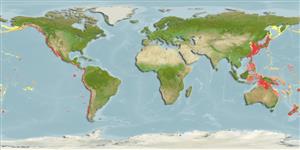分类 / Names
俗名 | 同种异名 | Catalog of Fishes(属, 种) | ITIS | CoL | WoRMS | Cloffa
Teleostei >
Scombriformes (Mackerels) >
Scombridae (Mackerels, tunas, bonitos) > Scombrinae
Etymology: Scomber: Greek, skombros = tunny or mackerel, 1623 (Ref. 45335); japonicus: Named after Japan, its type locality (Ref. 6885).
Environment: milieu / climate zone / depth range / distribution range
生态学
海洋; 海洋洄游的 (Ref. 51243); 深度上下限 0 - 300 m (Ref. 168), usually 50 - 200 m (Ref. 35185). 亞熱帶的; 10°C - 27°C (Ref. 35185); 60°N - 48°S, 116°E - 70°W
Indo-Pacific: anti-tropical, absent from the Indian Ocean except for South Africa, KZN to Western Cape (58304).
Reports from Atlantic incl. Mediterranean are Scomber colias, and from Red Sea and northern Indian Ocean are Scomber australasicus (Ref. 27328).
Circumglobal ,美國東岸從加拿大新斯科舍省到阿根廷東部.(參考文獻 47377) 為鰷魚鯖 Scomber japonicus 的印度-太平洋的分布; Scomber colias 被發現於大西洋。 (參考文獻 33246) Scomber japonicus 是顯然地印尼與澳洲沒有出現而且被 Scomber australasicus 取代.(參考文獻 9684) 族群從紅海與印度洋北部 (亞丁灣與阿曼) 是 Scomber australasicus 。 (參考文獻 27328) 在樣本從大西洋與印度-太平洋的族群之中的 haplotypes 的完全的區分顯示出他們可能需要被鑑定為個別的種.(參考文獻 30232)
Length at first maturity / 大小 / 重量 / 年龄
Maturity: Lm 26.1 range ? - ? cm
Max length : 64.0 cm TL 雄鱼/尚未辨别雌雄; (Ref. 9015); common length : 30.0 cm FL 雄鱼/尚未辨别雌雄; (Ref. 168); 最大体重: 2.9 kg (Ref. 26550); 最大年龄: 18 年 (Ref. 35185)
背棘 (总数): 9 - 11; 背的软条 (总数): 112; 臀棘 1; 臀鳍软条: 12 - 14; 脊椎骨: 31. Interpelvic process small and single. No well developed corselet. Swim bladder present. First haemal spine posterior to first interneural process; 12 to 15 interneural bones under first dorsal fin. Anal fin spine conspicuous, clearly separated from anal rays but joined to them by a membrane. Back with narrow stripes which zigzag and undulate. Belly unmarked (Pacific population) or with wavy lines (Atlantic pop.) (Ref. 168). Caudal peduncle with 5 finlets on the upper and lower edge. Distance between dorsal fins shorter than or equal to the first dorsal fin base (Ref. 35388).
腹鳍间的突起小的与单个。 没有发展良好的甲胄。 有泳鳔。 第一个脉棘第一个背侧间的突起后面; 在第一背鳍下面的 12 到 15个背侧间的硬骨。 臀鳍棘显着的, 清楚地与臀鳍鳍条分开了但是连到了他们经由一个膜。 背面有狭窄的斑纹曲折而且波动。 腹面无标记的 (太平洋族群) 或与波浪状的线 (大西洋的族群).(参考文献 168) 在上、下边缘上尾梗有 5个离鳍。 背鳍之间的距离短于或者等于第一背鳍基底.(参考文献 35388)
A coastal pelagic species, to a lesser extent epipelagic to mesopelagic over the continental slope (Ref. 168). Schooling by size is well developed and initiates at approximately 3 cm (Ref. 168); may also form schools with Sarda chiliensis, Trachurus symmetricus and Sardinops sagax (Ref. 9340). Adults stay near the bottom during the day; go up to the open water at night, (Ref. 5377) where they feed on copepods and other crustaceans, fishes and squids (Ref. 168). They spawn in batches (Ref. 51846). Eggs and larvae are pelagic (Ref. 6769). In Asian waters, they move to deeper water and remain inactive during the winter season (Ref. 4576). Commercially cultured in Japan. Marketed fresh, frozen, smoked, salted and occasionally canned (Ref. 9684). Eaten fried, broiled and baked (Ref. 9988). Used in Chinese medicine (Ref. 12166).
一个海岸的大洋性鱼种, 对在大陆斜坡上的一个较少的范围表层带到海洋中层带的鱼种.(参考文献 168) 依大小形成鱼群在大约 3 公分是发展良好的与新入会者;(参考文献 168) 也可能与 Sarda chiliensis , 太平洋竹 鱼[Trachurus symmetricus] 与 Sardinops sagax 形成鱼群。 (参考文献 9340) 停留在底部的附近在白天期间; 去向上到开放水域在晚上,(参考文献 5377) 在哪里它吃桡脚类的动物与其他的甲壳动物,鱼与乌贼.(参考文献 168) 在亚洲水域, 据说移动到较深的水域而且在冬季期间保持不活跃.(参考文献 4576) 商业地在日本养殖。 在市场上销售生鲜地了,冷冻,烟熏了, 盐腌与偶然罐装.(参考文献 9684) 油炸后食用, 火烤了而且烧烤了。 (参考文献 9988) 被用于中药材了。 (参考文献 12166)
Life cycle and mating behavior
成熟度 | 繁殖 | 产卵场 | 卵 | 孕卵数 | 仔鱼
Spawning most often occurs at water temperatures of 15° to 20°C. Spawn in several batches with 250 to 300 eggs per g of fish with the total number of eggs per female ranging from 100,000 to 400,000.Circumglobal ,美國東岸從加拿大新斯科舍省到阿根廷東部.(參考文獻 47377) 為鰷魚鯖 Scomber japonicus 的印度-太平洋的分布; Scomber colias 被發現於大西洋。 (參考文獻 33246) Scomber japonicus 是顯然地印尼與澳洲沒有出現而且被 Scomber australasicus 取代.(參考文獻 9684) 族群從紅海與印度洋北部 (亞丁灣與阿曼) 是 Scomber australasicus 。 (參考文獻 27328) 在樣本從大西洋與印度-太平洋的族群之中的 haplotypes 的完全的區分顯示出他們可能需要被鑑定為個別的種.(參考文獻 30232)
Collette, B.B. and C.E. Nauen, 1983. FAO Species Catalogue. Vol. 2. Scombrids of the world. An annotated and illustrated catalogue of tunas, mackerels, bonitos and related species known to date. Rome: FAO. FAO Fish. Synop. 125(2):137 p. (Ref. 168)
人类利用
渔业: 高经济性; 养殖: 商业性; 游钓鱼种: 是的; 诱饵: usually
工具
特别资料
下载 XML
网络资源
Estimates based on models
Preferred temperature (Ref.
123201): 9.3 - 27.7, mean 20.7 °C (based on 1526 cells).
Phylogenetic diversity index (Ref.
82804): PD
50 = 0.5625 [Uniqueness, from 0.5 = low to 2.0 = high].
Bayesian length-weight: a=0.00741 (0.00662 - 0.00830), b=3.05 (3.02 - 3.08), in cm total length, based on LWR estimates for this species (Ref.
93245).
营养阶层 (Ref.
69278): 3.4 ±0.1 se; based on diet studies.
Generation time: 3.6 (3.1 - 5.0) years. Estimated as median ln(3)/K based on 24
growth studies.
回复力 (Ref.
120179): 中等的, 族群倍增时间最少 1.4 - 4.4年 (K=0.12-0.22; tm=2-3; tmax=18).
Prior r = 0.48, 95% CL = 0.32 - 0.73, Based on 3 stock assessments.
Fishing Vulnerability (Ref.
59153): Low to moderate vulnerability (31 of 100).
Climate Vulnerability (Ref.
125649): Low vulnerability (24 of 100).
Nutrients (Ref.
124155): Calcium = 48.8 [16.2, 118.3] mg/100g; Iron = 2.18 [0.83, 5.26] mg/100g; Protein = 20.9 [19.8, 21.8] %; Omega3 = 0.358 [0.247, 0.525] g/100g; Selenium = 98.1 [37.9, 229.9] μg/100g; VitaminA = 13.7 [3.5, 60.5] μg/100g; Zinc = 0.846 [0.514, 1.358] mg/100g (wet weight); based on
nutrient studies.
